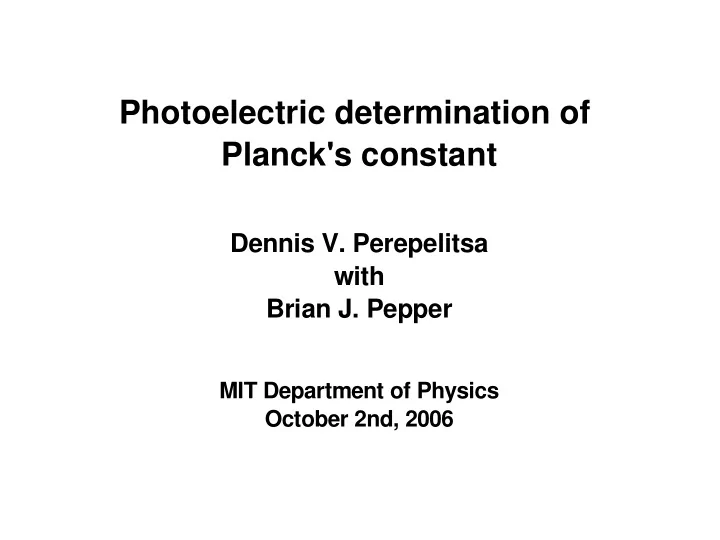

Photoelectric determination of Planck's constant Dennis V. Perepelitsa with Brian J. Pepper MIT Department of Physics October 2nd, 2006
Introduction Contents I. Theory History II. Experimental Setup III. Raw Data * 1895 – Hertz discovers photoelectric effect. IV. h - Naïve Method * 1900 – Planck proposes energy is quantized. V. h - Naïve Error Analysis * 1905 – Einstein links this with the photoelectric effect. VI. h – Alternate Method * 1912 – Richardson and Compton test this claim, VII. h – Alternate Error Analysis determine h . VIII. Conclusion IX. Acknowledgment Summary We measure h the same way that Richardson and Compton did – by opposing the photocurrent caused in a circuit by the photoelectric effect with a retarding voltage. We calculate the retarding voltage using two different methods. We plot voltage against frequency, and find a line of best fit to measure h .
I. Theory Under the quantum model: * A photon incident on a metal sheet has energy proportional to its frequency. * If the energy is high enough to liberate an electron, the electron escaped with some energy. * The energy is equal to the difference between the incident energy and work function. If we apply a retarding voltage across the circuit in which the electron will flow, we see that there is a measurable current given by: We know when the retarding voltage becomes equal to the incident energy (less the work function) because the current becomes constant. Thus, we can plot voltage versus incident energy, and calculate a value for h. (Specifically, h/e) What are the consequences of this theory that we are testing? * E/frequency is constant and close to the established value of h. * There is a cut-off frequency past which there is no photocurrent.
II. Experimental Setup Accuracy of Equipment * Power Supply: ± .01V * Electrometer: three sig figs. * Filter Wheel: 3650 A, 4047 A, 4358 A, 5461 A, 5770 A, all ± 20 A. Procedure * Lamp was warmed up and positioned until current reached a maximum. * Positive output of electrometer, as well as every apparatus in general was grounded. * Four trials per wavelength. * Additional data points around where the current fell to zero. (Figure modified from Lab Guide: http://web.mit.edu/8.13/www/JLExperiments/JLExp005.pdf)
III. Raw Data * The 3650 A, 4047 A, 4058 A lines look good. * The 5461 A line: * Corresponds to photons with 1% less energy than phi. * However, there is a noticable effect --> so we keep it. * The 5770 A line: * Significantly lower energy than phi. * Looks like background radiation --> so we discard it. * All spectral lines: * I/V not a straight line --> distributed energy. * Current becomes non-zero (negative, in fact), and constant.
IV. & V. Naïve Method & Error Analysis Summary The retarding voltage is the value for which the current is closest to zero. Determine the line of best fit. Error Analysis We do a conservative analysis. Results
VI. Alternate Method Summary Find intersection of tangent line and constant, negative current, and use that value as the value of the retarding voltage. This is suggested by Melissinos. Why? * Tangent line is a better model of how increasing the voltage acts on current. * Negative current is a better model for when the retarding voltage negates the photocurrent entirely. How? * Tangent line calculated from the top half of the data points - “before significant deviation”. * Negative current calculated from last three data points.
VII. Alternate Method Error Analysis The calculation of the retarding voltage is more involved. Three components to relative error. * Error in V. We consider the median of these. * Error in the frequency. We consider the largest of these. * Error in the negative current. We consider the largest spread.
VIII. Conclusion Good or bad? * The ratio of E/frequency is constant. Good. * Cut-off frequency is observed. Good. * Several standard deviations away from the established value of h. Very Bad. What didn't go wrong (probably)? * Systematic errors that bias the voltage or current in one direction only. * Ambient light. * Improper grounding. * Fitting to 1nA has no effect on calculation of the retarding voltage. What went wrong? * We don't know! * Odd error.
IX. Acknowledgments Brian Pepper, an equal partner in collecting the experimental data, who also helped me rehearse. Professor Isaac Chuang and Dr. Scott Sewell, who answered our questions while we performed the experiment.
Classical Metal Atom A classical metal atom with d = .3nm, irradiated with intensity W = 1mW/m^2, with a work function = 4 eV, will take: t = E / WA = (4)(1.6e-19) / (1e-3 * .15nm^2 * 3.14) = 2.5 hours to excite an electron.
Calculation of the work function Taking the y-intercept using the Naïve Method: phi ~= 1.1 V Taking the y-intercept using the Alternate Method: phi ~= .93 V Which is not consistent with the stated value.
Recommend
More recommend